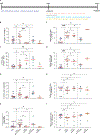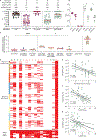Heterologous prime-boost vaccination drives early maturation of HIV broadly neutralizing antibody precursors in humanized mice
- PMID: 38753806
- PMCID: PMC11233128
- DOI: 10.1126/scitranslmed.adn0223
Heterologous prime-boost vaccination drives early maturation of HIV broadly neutralizing antibody precursors in humanized mice
Abstract
A protective HIV vaccine will likely need to induce broadly neutralizing antibodies (bnAbs). Vaccination with the germline-targeting immunogen eOD-GT8 60mer adjuvanted with AS01B was found to induce VRC01-class bnAb precursors in 97% of vaccine recipients in the IAVI G001 phase 1 clinical trial; however, heterologous boost immunizations with antigens more similar to the native glycoprotein will be required to induce bnAbs. Therefore, we designed core-g28v2 60mer, a nanoparticle immunogen to be used as a first boost after eOD-GT8 60mer priming. We found, using a humanized mouse model approximating human conditions of VRC01-class precursor B cell diversity, affinity, and frequency, that both protein- and mRNA-based heterologous prime-boost regimens induced VRC01-class antibodies that gained key mutations and bound to near-native HIV envelope trimers lacking the N276 glycan. We further showed that VRC01-class antibodies induced by mRNA-based regimens could neutralize pseudoviruses lacking the N276 glycan. These results demonstrated that heterologous boosting can drive maturation toward VRC01-class bnAb development and supported the initiation of the IAVI G002 phase 1 trial testing mRNA-encoded nanoparticle prime-boost regimens.
Conflict of interest statement
Figures







References
-
- UNAIDS, The path that ends AIDS: UNAIDS Global AIDS Update 2023. (2023).
-
- Pegu A, Borate B, Huang Y, Pauthner MG, Hessell AJ, Julg B, Doria-Rose NA, Schmidt SD, Carpp LN, Cully MD, Chen X, Shaw GM, Barouch DH, Haigwood NL, Corey L, Burton DR, Roederer M, Gilbert PB, Mascola JR, Huang Y, A Meta-analysis of Passive Immunization Studies Shows that Serum-Neutralizing Antibody Titer Associates with Protection against SHIV Challenge. Cell Host Microbe 26, 336–346 e333 (2019); (10.1016/j.chom.2019.08.014). - DOI - PMC - PubMed
-
- Huang Y, Zhang L, Eaton A, Mkhize NN, Carpp LN, Rudnicki E, DeCamp A, Juraska M, Randhawa A, McDermott A, Ledgerwood J, Andrew P, Karuna S, Edupuganti S, Mgodi N, Cohen M, Corey L, Mascola J, Gilbert PB, Morris L, Montefiori DC, Prediction of serum HIV-1 neutralization titers of VRC01 in HIV-uninfected Antibody Mediated Prevention (AMP) trial participants. Human vaccines & immunotherapeutics 18, 1908030 (2022); (10.1080/21645515.2021.1908030). - DOI - PMC - PubMed
-
- Corey L, Gilbert PB, Juraska M, Montefiori DC, Morris L, Karuna ST, Edupuganti S, Mgodi NM, deCamp AC, Rudnicki E, Huang Y, Gonzales P, Cabello R, Orrell C, Lama JR, Laher F, Lazarus EM, Sanchez J, Frank I, Hinojosa J, Sobieszczyk ME, Marshall KE, Mukwekwerere PG, Makhema J, Baden LR, Mullins JI, Williamson C, Hural J, McElrath MJ, Bentley C, Takuva S, Gomez Lorenzo MM, Burns DN, Espy N, Randhawa AK, Kochar N, Piwowar-Manning E, Donnell DJ, Sista N, Andrew P, Kublin JG, Gray G, Ledgerwood JE, Mascola JR, Cohen MS, Hvtn H, Teams HHS, Two Randomized Trials of Neutralizing Antibodies to Prevent HIV-1 Acquisition. N Engl J Med 384, 1003–1014 (2021); (10.1056/NEJMoa2031738). - DOI - PMC - PubMed
Publication types
MeSH terms
Substances
Grants and funding
LinkOut - more resources
Full Text Sources

